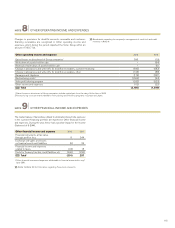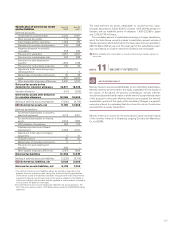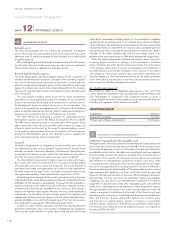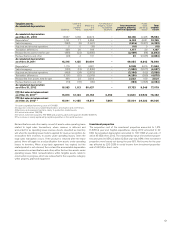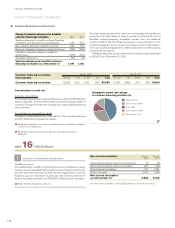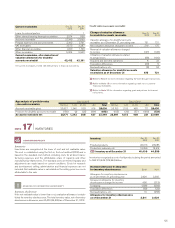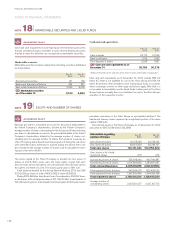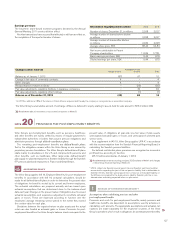Volvo 2012 Annual Report Download - page 122
Download and view the complete annual report
Please find page 122 of the 2012 Volvo annual report below. You can navigate through the pages in the report by either clicking on the pages listed below, or by using the keyword search tool below to find specific information within the annual report.
Intangible assets
The Volvo Group applies the cost method for recognition of intangible
assets. Borrowing costs are included in the cost of assets that necessarily
take more than 12 months to prepare for their intended use or sale, known
as qualifying assets.
When participating in industrial projects in partnership with other compa-
nies the Volvo Group in certain cases pays an entrance fee to participate.
These entrance fees are capitalized as intangible assets.
Research and development expenses
The Volvo Group applies IAS 38, Intangible Assets, for the recognition of
research and development expenses. Pursuant to this standard, expendi-
tures for the development of new products, production systems and soft-
ware are recognized as intangible assets if such expenditures, with a high
degree of certainty, will result in future financial benefits for the company.
The cost for such intangible assets is amortized over the estimated useful
life of the assets.
The rules require stringent criteria to be met for these development
expenditures to be recognized as assets. For example, it must be possible
to prove the technical functionality of a new product or software prior to
its development being recognized as an asset. In normal cases, this
means that expenditures are capitalized only during the industrialization
phase of a product development project. Other research and development
expenses are recognized in the Income Statement as incurred.
The Volvo Group has developed a process for conducting product
development projects named the Global Development Process (GDP).
The GDP has six phases focused on separate parts of the project. Every
phase starts and ends with a reconciliation point, known as a gate, the
criteria for which must be met for the project’s decision-making commit-
tee to open the gate and allow the project to progress to the next phase.
During the industrialization phase, the industrial system is prepared for
series production and the product is launched.
Goodwill
Goodwill is recognized as an intangible asset with indefinite useful life. For
non-depreciable assets such as goodwill, impairment tests are performed
annually, as well as if there are indications of impairments during the year,
by calculating the asset’s recovery value. If the calculated recovery value is
less than the carrying value, the asset’s recovery value is impaired.
The Volvo Group’s measurement model is based on a discounted cash-
flow model, with a forecast period of four to six years. Cash-generating
units, identified as business areas, are measured. The Trucks segment is
considered one single cash-generating unit under the new organization.
Goodwill related to the area Trucks is therefore evaluated based on the
cash generation capacity of the overall Trucks segment from 2012.
Goodwill assets are allocated to these cash-generating units on the basis
of anticipated future utility. Measurements are based on management’s best
estimation of the operations’ development. The basis for this estimation is
long-term forecasts of the market’s growth of 2% (2), in relation to the per-
formance of the Volvo Group’s operations. In the model, the Volvo Group is
expected to maintain stable capital efficiency over time. Other parameters
considered in the calculation are gross margin, product mix, expenses and
capital needs. Measurements are based on nominal values and utilize a gen-
eral rate of inflation in line with the European target. The Volvo Group uses a
discounting factor calculated to 12% (12) before tax for 2012.
In 2012, the value of Volvo’s operations exceeded the carrying amount of
goodwill for all business areas, which is why no impairment was recognized.
Volvo has also tested whether a surplus value would still exist after being
subjected to reasonable potential changes to the assumptions, negatively
adjusted by one percentage point on an individual basis, whereof no adjust-
ment would have sufficient impact to require impairment for any business area
except Volvo Rents. For Volvo Rents the recovery value, calculated based on
discounted cash flows, exceeded the carrying amount of 8,643 with 1,088. A
reduction of the dollar utilization rate with 0.9 percentage points or an
increase of the discounting factor to 13% would eliminate the surplus value.
Since the surplus values differ between the business areas, they are to
a varying degree sensitive to changes in the assumptions described
above. Therefore, the Volvo Group continuously follows the performance
of the business areas whose overvalue is dependent on the fulfillment of
the Volvo Group’s assessments. Instability in the recovery of the market
and volatility in interest and currency rates may lead to indications of a
need for impairment. The most important factors for the future operations
of the Volvo Group are described in the Volvo Group business area sec-
tion, as well as in the Risk management section.
Amortization and impairment
Amortization is made on a straight-line basis based on the cost of the
assets, adjusted in appropriate cases by impairments, and estimated useful
lives. Amortization is recognized in the respective function to which it
belongs. Impairment tests for amortizable assets are performed if there are
indications of impairment at the balance sheet date.
Amortization periods
Trademarks 20 years
Distribution networks 10 years
Product and software development 3 to 8 years
ACCOUNTING POLICIES
Impairment of goodwill and other intangible assets
Intangible assets other than goodwill are amortized and depreciated over
their useful lives. Useful lives are based on estimates of the period in which
the assets will generate revenue. If, at the date of the financial statements,
any indication exists that an intangible non-current asset has been impaired,
the recoverable amount of the asset is calculated. The recoverable amount
is the higher of the asset’s net selling price and its value in use, estimated
with reference to management’s projections of future cash flows. If the
recoverable amount of the asset is less than the carrying amount, an impair-
ment loss is recognized and the carrying amount of the asset is reduced to
the recoverable amount. Determination of the recoverable amount is based
upon management’s projections of future cash flows, which are generally
based on internal business plans or forecasts. While management believes
that estimates of future cash flows are reasonable, different assumptions
regarding such cash flows could materially affect valuations. The need for
impairment of goodwill and certain other intangible assets with indefinite
useful lives is determined on an annual basis, or more frequently if required
through calculation of the value of the asset. Such an impairment review will
require management to determine the fair value of the Volvo Group’s cash
generating units, on the basis of projected cash flows and internal business
plans and forecasts. Surplus values differ between the business areas
and they are, to a varying degree, sensitive to changes in assumptions
and the business environment. Volvo Group has performed similar impair-
ment reviews since 2002. No need for impairment losses was required for
the period 2002 until 2012.
SOURCES OF ESTIMATION UNCERTAINTY
!
NOTE 12
INTANGIBLE ASSETS
NOTES TO FINANCIAL STATEMENTS
FINANCIAL INFORMATION 2012
118









